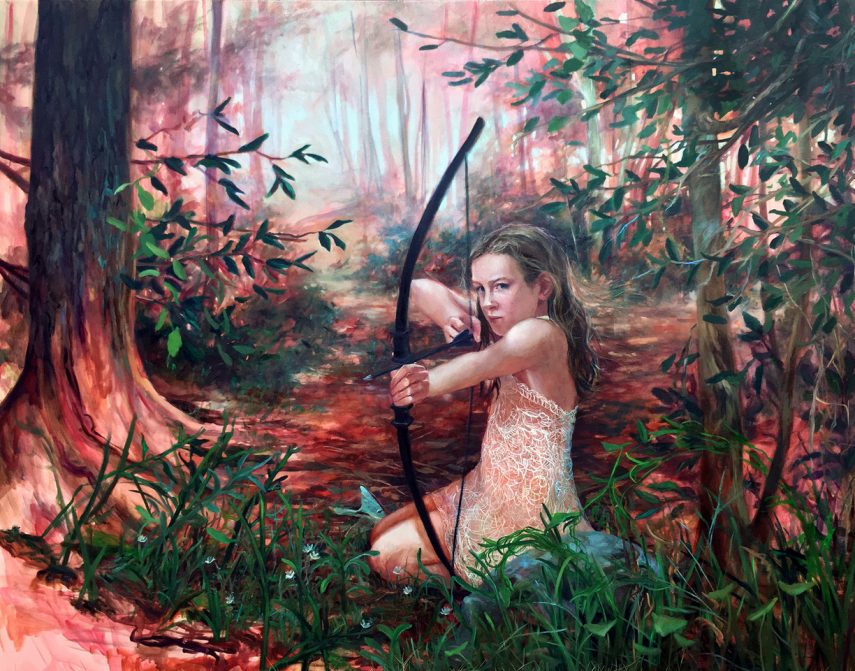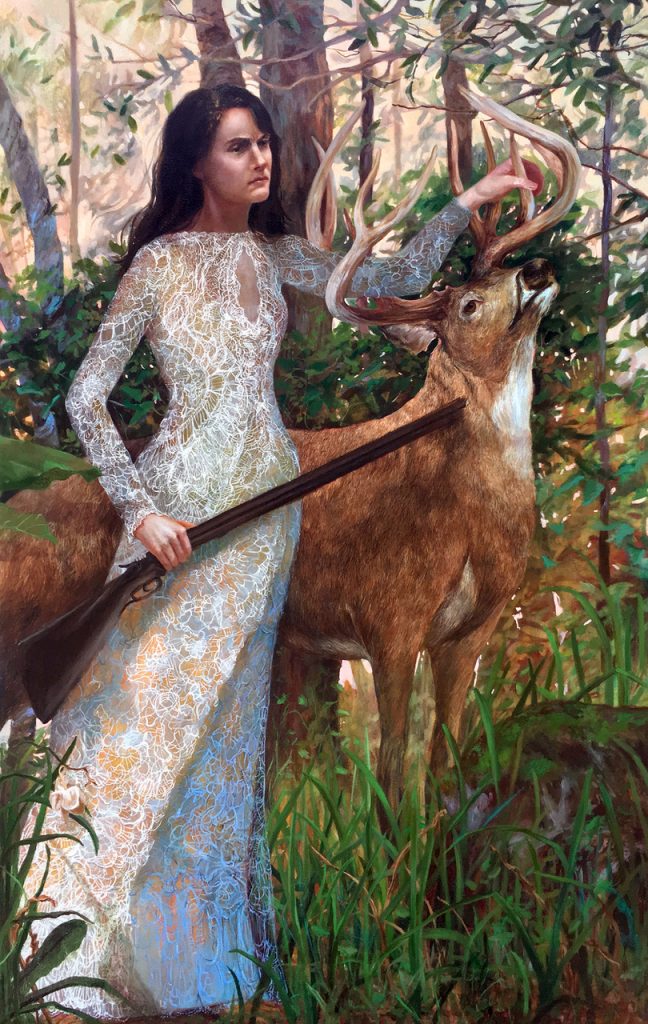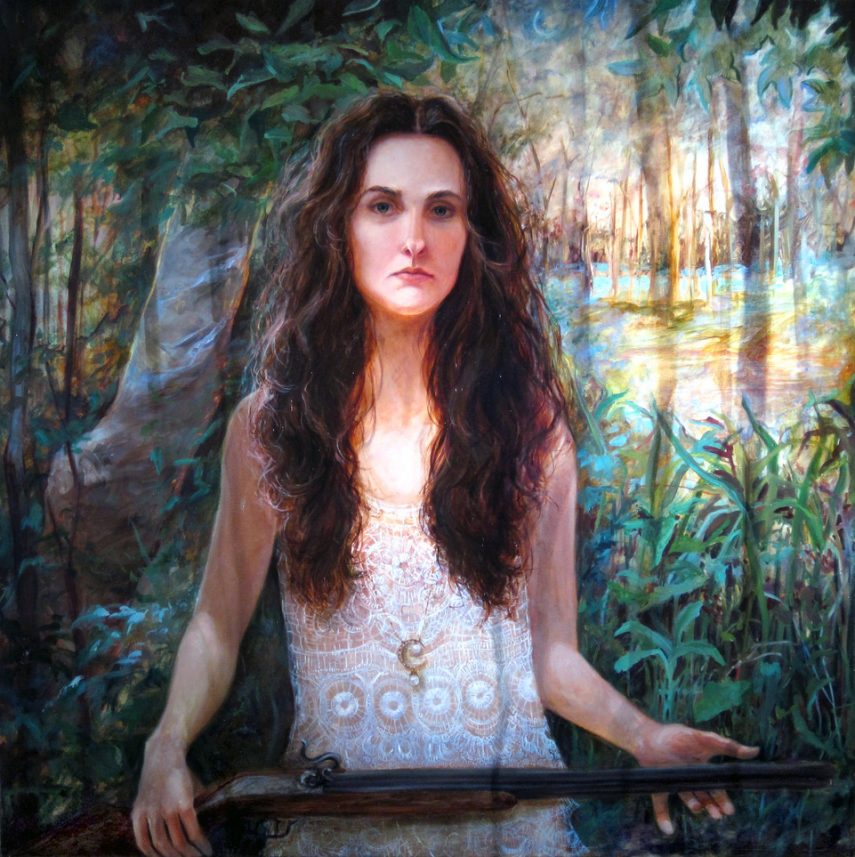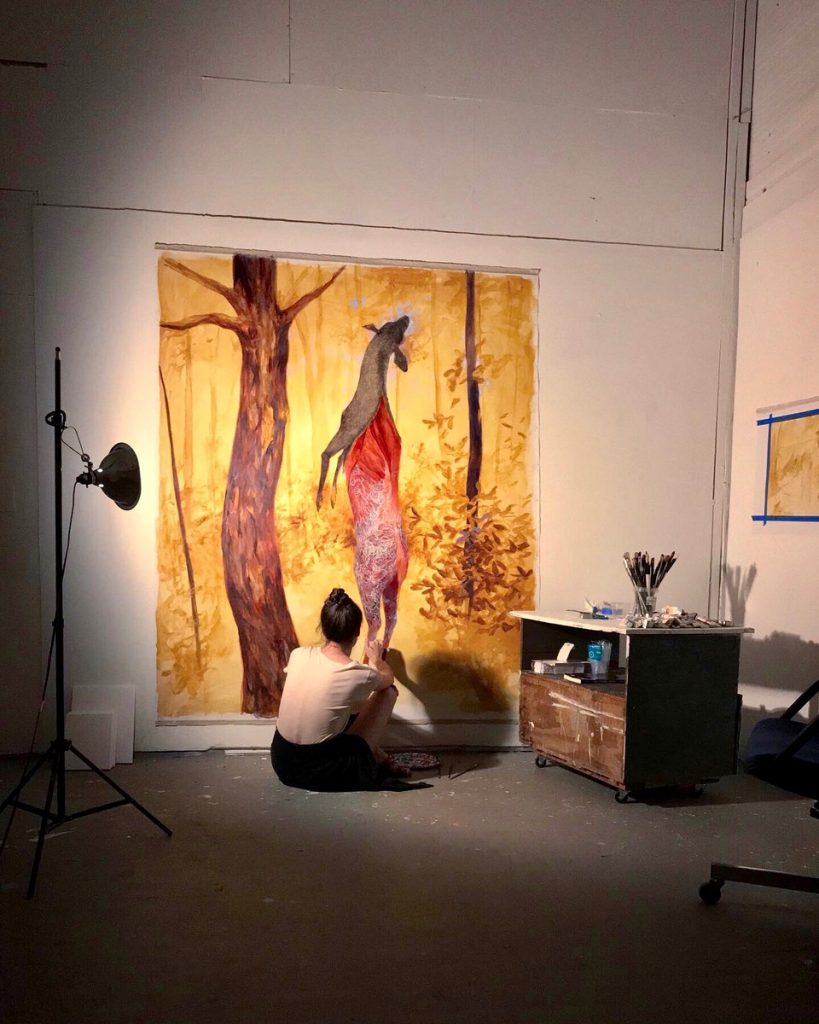Local Spotlight: An Interview with Artist Lauren Woods
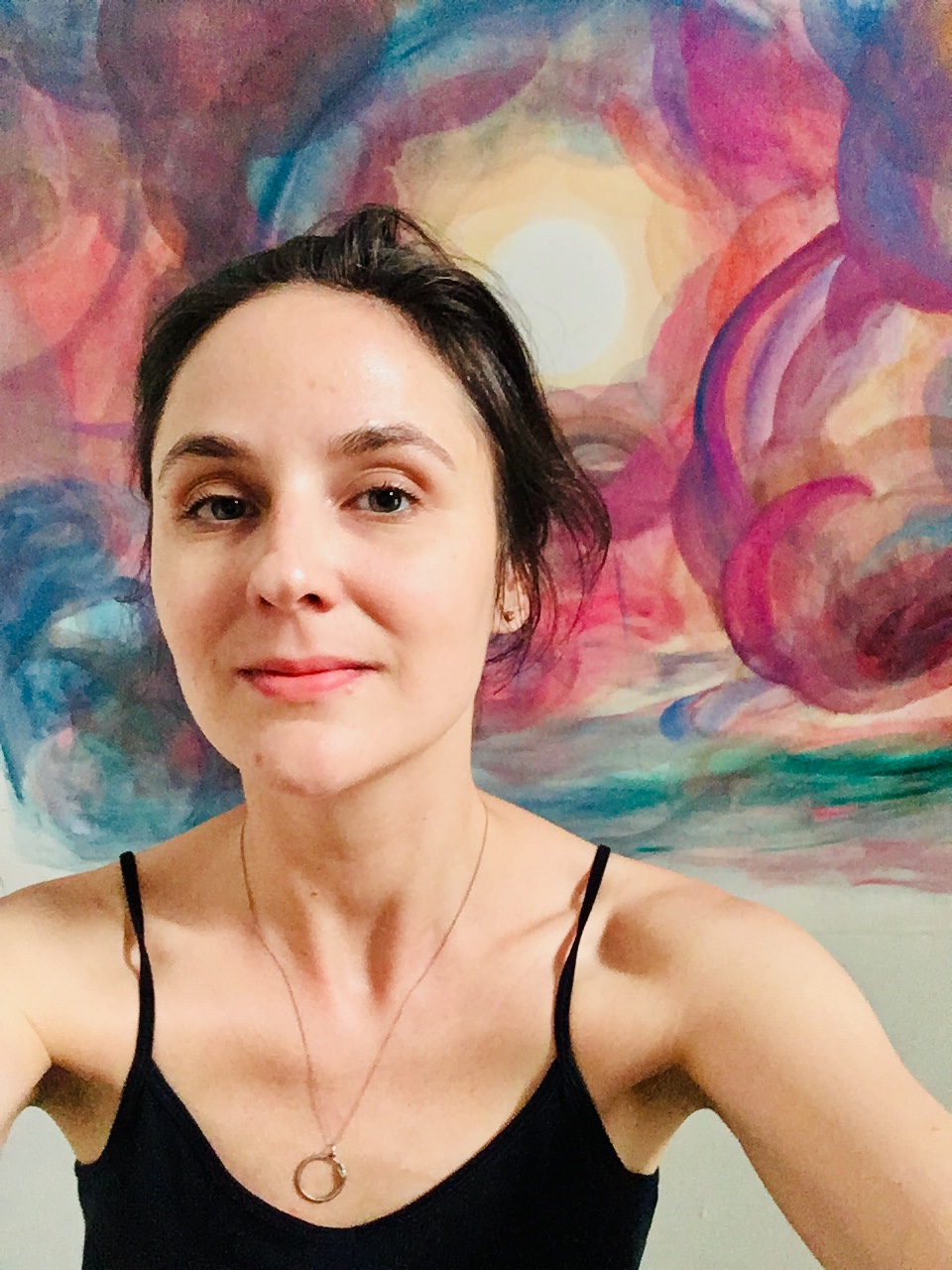
Lauren Woods draws from art history, religious iconography and comparative mythology to construct paintings that explore the nature of images along with the transformational characteristics of the human form. In 2006 Lauren received her BA in studio art from Spring Hill College. She then completed an MFA in painting at the New York Academy of Art in 2010. Currently, she is an Assistant Professor of Art at Auburn University. In addition to painting, she has an extensive background as a classical ballet dancer, and her work is influenced by the ethereal and lyrical aesthetic of the art form. laurenwoodsart.com
Interview by E.E. HUSSEY
Black Warrior Review: What led to your exploration of the theme “woman as archetypal hunter” in your paintings?
Lauren Woods: A continued interest in mythology as a way to express underlying themes through story-telling and metaphor has led to the imagery that I create. This particular theme has been my way to figure out how I fit into the broader scheme as a single, childless female in an environment that often measures your value as a woman by your connection to others. I have nothing against marriage and motherhood, I think they are beautiful, but my personal story doesn’t yet and may never include them. Through both my work and my path as an artist, I am trying to deeply understand who I am as an individual outside of my connection to others. I felt like the huntress archetype fits this process seamlessly because in stories she exists with autonomy in her own power.
Furthermore, this archetype doesn’t only have to be connected to individuals in similar situations as me, she can basically serve as a strong female presence in any circumstance. I often paint my sister who is both a mother and married as the huntress, because I admire her strength and ability to juggle a career and a family. I think this archetype is fluid in that way, allowing for a wide range of stories and interpretation. I am imagining the huntress as a woman that lives her life on her own terms.
Little Hunter, 2018, oil on canvas, 48”x 60”
BWR: Your work in progress, “Field Dress,” features a suspended doe occupying a liminal space between death and the threshold of field dressing. In other pieces, the nonhuman takes on male form. Was this shift deliberate?
LW: Yes, the shift to a female deer was deliberate in this piece. It is responding to the vulnerability felt in the current political climate where women’s reproductive health and rights are on the forefront. Whatever side of the debate you are on, it is strange to think how much power politics hold over our lives. This current discourse also makes one realize how vulnerable women have been throughout time to powers outside of our control. I created this image in response to feelings of powerlessness, despite how many advances females may have made over time. It seems counter-productive to make an image reflecting that feeling, but in its making I am regaining a sense of power because I have complete authority over the creation of the image.
Lady Killer, 2017, oil on wood, 72”x 48”
BWR: You grew up in Alabama and are now an assistant professor at Auburn. How is your work informed by your experiences in the South?
LW: I would say my visual language is influenced by the culture and landscape of Mobile, Alabama. I spent much of my childhood visiting Dauphin Island because we lived nearby. It has a bird sanctuary where you walk through the forest to get to the beach that is dreamlike and nearly untouched by development. The memory of the way the light shines through the trees still influences my work visually, and the imaginary stories I would create in response to the space influence my work conceptually.
Mobile is home to the visual spectacle of Mardi Gras. It is kind of like performance art, where the play comes out into the world mixing what is real and make-believe. Larger than life painted sculptures roll through the downtown area, bands play music and people wear masked costumes throwing random junk at the crowd. It is surreal and fun and nightmarish at the same time.
Additionally, I often think about the contradictions of growing up in the South. There is so much visual beauty with landscape and architecture, rich cultural traditions alongside poverty, violence, and historical memories and wounds from these things. I suppose many places could have the same contradictions, I am just speaking from living the majority of my life in the region.
BWR: How has your training in classical ballet influenced your painting process? You mentioned that in performance “one exists in a contradictory space between fantasy and reality.” Does your painting process mirror your approach to dance?
LW: The way I approach space and environments visually in the paintings is directly influenced by my experiences onstage. My first experience with the sublime happened backstage at five years old, we had an outer-space themed recital and I remember staring at the large stage sets and feeling so small, wondering what it would be like to be lost in space detached from everything and everyone I loved. Of course, at five I didn’t know of the concept of the sublime, I just remember a feeling of terror and fascination trying to imagine such a distance from everything and everyone.
I remember how strange it felt going onstage with the lights on us all, staring into the darkness, performing the routine we practiced all year in a completely different and artificial environment. Time felt as though it wasn’t real then, as if it was suspended in some way. That feeling never went away for the next 25 years or so that I performed onstage. Once I became more serious about ballet and performed in full-length productions, I was able to experience this feeling for longer stretches and more intensely. Those moments were the most potent to me, where I felt the most present, even though I was performing something that was complete make-believe. I have never felt more alive and transcendent as when I was pretending to be something like a swan or a snow fairy. Maybe it was because the dances were so difficult and there was tremendous elation in getting through them. It is kind of humorous in a way. It could also tie to an underlying human inclination towards ritual and performance, which is one basis of civilization. I am currently exploring themes of dance and ritual for some new work. I need to do more research into the history of social dance to see any types of common practices amongst different cultures.
Conceptually, I am attracted to depicting naturalistic subjects in theatrical environments because it creates a visual tension, blurring what is supposed to be “real” and what is pretend. Of course, the whole thing is artificial because it is painted, but it adds an extra layer of what I am intending for the audience to view as “real.” I want my paintings to function in a similar way to dreams, where images and events often represent something else that is happening in your daily life becoming manifest in a symbolic way. The images I make have specific meanings and symbolism to me, but it isn’t important that viewers understand them in the exact same way as I do. However, it is important that viewers know I am not making images to be taken literally. For example, when I depict guns it isn’t because I am trying to make a literal painting about gun rights. To me they are symbols of power and something fearful. I am not meaning for symbols to be read as signs. Sometimes this can get lost in translation. I am working on ways to better communicate this without someone having to read my artist statement, but it can be difficult.
Technically, the way the images are painted are also a reflection of my dance experiences. There is an obsessiveness and precision in some areas mixed with more lyrical and intuitive passages of paint that embodies what it is like to train and perform as a classical ballet dancer.
BWR: In addition to your training as a ballet dancer, you cite story-telling traditions as influences in your work. How is this reflected in your paintings or your process?
LW: I already state a little bit about how I am inspired by stories thematically in some other questions, but the mythology of “the artistic genius” also influences my process. I am consciously using a visual language of allegorical figurative paintings of Western Art that is influenced by works that are considered as “masterpieces” of priceless cultural worth in museums.
A major driving force in my artistic practice remains an insatiable yearning to create a masterpiece of painting, personally defined as a timeless artwork that exists as an iconic image in the collective conscious. Through the use of allegorical figure painting’s vocabulary of form, I intend to align myself with the mostly male artists who have been canonized as “creative geniuses” within the history of art. As both an artist and educator, I am aware of the disparity in this label across genders. Through careful study and assimilation, I contemplate which qualities make their work exist in the exalted space of “artistic masterpiece,” musing if they had the ability to do this, why can’t I?
The act of embodying the role of a figurative history painter connects to my desire to create something indelible and perpetually present. The act of painting becomes a contemplation of the corporeal and spiritual aspects of my own nature: a fanciful and awkward attempt to be one with the artists revered in the artistic pantheon whose visions are still alive today. With this, the act of painting becomes a performance in a sense. I am envisioning my paintings as a time-traveling experience: I want them to look as though they were made at the same time as the paintings from the past that I admire, such as the works by Renaissance artists Titian and Botticelli and just found today, but from a contemporary feminine point of view and insight.
The very idea of a masterpiece remains something that is mythological, antiquated, and steeped in power dynamics. The concept didn’t always exist in art, and then it later became an idea for artists to conquer and destroy as time progressed. Despite all of this, the concept still exists in our imaginations, and can be witnessed when visiting any major museum. I guess that is why I am so immersed in trying to better understand it through painting.
Hunting Portrait, 2015, oil on canvas, 36”x 36”
BWR: Myths and fairy tales also influence your work. Which tales or myths are you drawn to or have had the most influence on your painting?
LW: I am often drawn to stories where the character has to venture into the forest and is nearly helpless because it is what it often feels like going through life as you gain more responsibilities and moments of learning, or how it feels when one decides to take the time to understand one’s inner-most thoughts, fears, and desires. The forest then becomes a metaphor for venturing into the dark and unexplored parts of yourself. I am also drawn to stories of long journeys where the main character goes through some sort of transformational experience.
I have recently made a small series of paintings inspired by the Odyssey, exploring the idea of spaces that could be viewed as simultaneously internal and external. In other words, how we perceive spaces in our memory or when we are visualizing them while reading or in dreams. They tend to have a basis in real places you have seen but are also constructed from your imagination. In these types of images, I am attempting to capture ambiance that cannot be put into words and could possibly remind the viewer of places they may have visited or read about in the past. Ideally, I am not illustrating stories that influence me, but rather visually suggesting various aspects of them to create new narratives.
BWR: What do you hope viewers take away from your paintings?
LW: My ultimate goal as a painter, which I don’t think you could possibly ever know, is to create a suspended moment of time for the viewer, where they feel the past and the present colliding. To observe a painting fully, one has to share space with it physically, creating a communion between the artist and viewer that exists outside of a linear and systematic perception of time. As a result, a painting exists as a fixed object with potential to exceed its physical form to ascend to something higher.
The most compelling art experiences I have had involve a sense of empathy and feeling of being connected to the artist in a deeply human way, and doesn’t always tie to what is depicted, but more so how it is made. In this type of experience, the physicality of the paint changes your perception of the work. Something you may have seen hundreds of times reproduced in books or online can completely transform when you see the actual hand-made object. I want my work to act in these ways, becoming a mirror for one to project their own experiences and understanding, encouraging a living dialogue within the viewer.
Field Dress (in progress), oil on linen, 68”x 80”
BWR: What else are you currently working on?
LW: My latest exploration has been into animation. For a while I have wanted to make my paintings take on the element of movement. I recently worked on a performance project called Body Tides in collaboration with Billy Blanken, who directs Sheep Meadow Dance Theatre based in Long Island City, NY and a NY based musician, Jack Ray.
I used Adobe After Effects to create animations of original paintings, and dancers performed a piece influenced by the concept of the ancient belief of our bodies being controlled by the cycles of the moon/cosmos. I would like to take this medium farther, exploring various methods of projection and possibilities of transforming a space to give the viewers a more immersive experience.
